Your new boyfriend’s parents are coming over this evening and the menu is all planned out. You’ve spent hours slaving away on an almond torte.
Then the boyfriend texts to remind you that his dad is extremely allergic to nuts, and you shouldn’t even have them on the table. Now what?
Try a new take on an old classic: Meringue.

Sound intimidating? It doesn’t have to be!
Maybe Grandma’s lemon pie is an old family tradition, but you’ve yet to try her recipe because of that fear of meringue. Heck, even trying to spell the word is complicated!
Or maybe you’ve learned that Baked Alaska is your new boss’s favorite dessert and you really need to butter him up, but you can’t seem to get the meringue down.
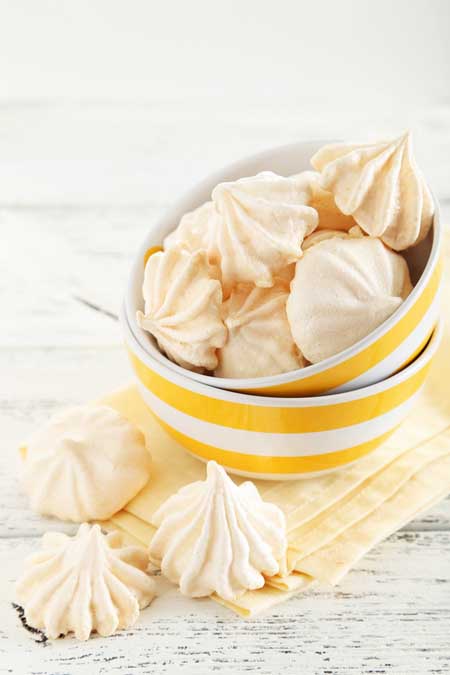
Some of the simplest desserts, like pudding pies or basic cookies, can become sophisticated just by using the magic of meringue. A few egg whites, sweetener, and a mixer are all you really need to turn dull into dazzling, average into astounding.
Plus, because egg whites are a low calorie food that is high in protein and free of fat, it is possible to create a scrumptious looking (and tasting!) dessert that actually has some nutritional value. Egg whites are also rich in calcium, magnesium, potassium, and phosphorous—all of which are important to a healthy diet.
Also, meringue is gluten free and dairy free, which can be a big deal these days, with food allergies on the rise.
What about making a vegan creation? No problem!
We have the perfect vegan meringue recipe for you, which uses the magic of aquafaba: an excellent egg replacement and thickener. And you might also want to check out other egg-free baking ideas!
How Do Meringues Work?
The science of meringue is actually rather simple. The protein in the egg whites is unfolded during the beating or whisking process. As the protein unfolds, it forms a film that traps air bubbles, while the sugar creates stiffness in the mixture.
As beating time increases, the bubbles minimize in size and become more numerous, thus increasing the volume and creating a stable, stiff constitution.
Equipment Needed
Clean, dry bowls and utensils are critical for making the best meringue. Any type of moisture can ruin the eggs’ ability to be whipped. This means that you may even want to avoid planning to make meringue on a particularly humid day, in order to get the best results.
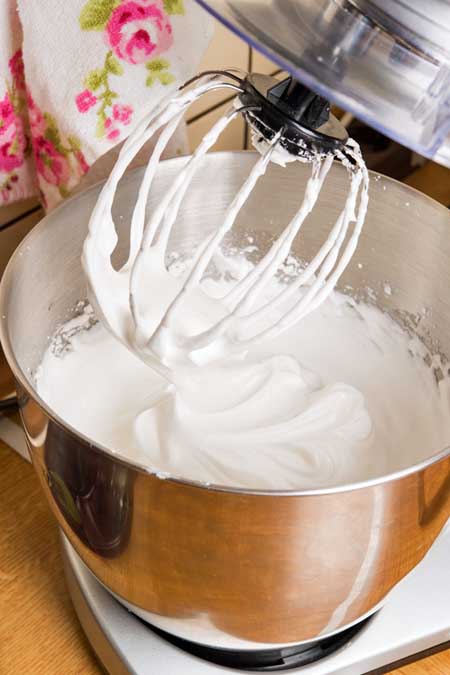
Stainless steel, copper, or glass bowls are best for meringue making. Chefs often prefer copper because it seems to react well with the egg white, producing a great deal of fluffiness. (If using a copper bowl, clean it with salt and vinegar first). But stainless steel and glass are effective as well.
Unlike plastic, glass or metal bowls are not likely to hide trace amounts of grease or fat. Basically, fat = death to fluffy egg whites.
Even the tiniest bit of oil from your hands can cause problems with meringue, so it’s important to wash your hands and avoid touching the parts of the beaters and bowl that will touch the egg whites – treat it kind of like you’re scrubbing for surgery.
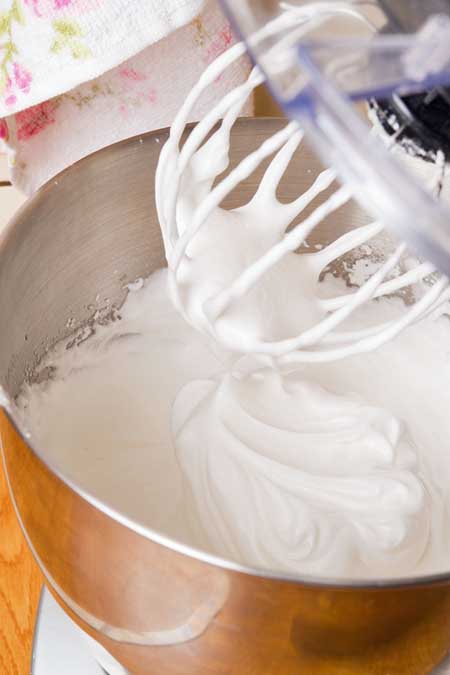
Using a stand mixer is best for making meringue. A hand mixer will also work, but may cause a great amount of fatigue because of the long time that it could take to get your peaks to form. A fine wired whisk is likely to be most effective when making a meringue, but regular beaters will work also.
Separating Eggs
Because there is some fat in the yolks, it is important to be sure that your eggs are well separated, and that any traces of yolk are eliminated. Cold eggs are easier to separate, so start with eggs straight from the refrigerator.
Some people like to use various pieces of equipment for separating eggs, but nothing is really required except for two bowls, where you will place the egg yolks and whites as you separate them. Of course, whatever you use needs to be super clean and grease free.
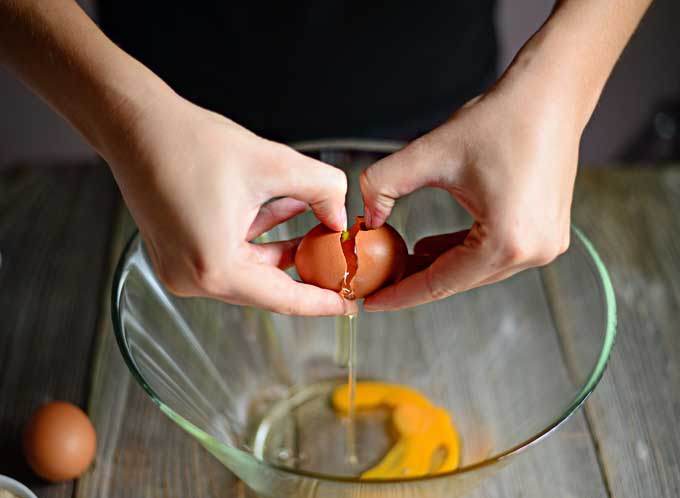
The easiest way to separate yolk from white is to gently crack the side of the egg on a flat surface. Using the corner of a counter or bowl increases the possibility that the yolk will be punctured, and the egg will not separate well.
Hold the egg upright for a moment to allow it to settle in one end of the shell. With the egg poised over one of the bowls, gently open the shell with your fingers, and transfer the yolk back and forth from one side of the shell to the other. This should cause the egg whites to drain into the bowl, until there are no traces of white left in the shell. Transfer the yolk to the other bowl and start over with the next egg.
Separate eggs individually into small bowls before placing them into the larger batch. This will keep the batch pure, and you’ll only lose one egg if you are not able to get it separated well, rather than contaminating the whole lot. This makes it a bit easier to pick out any pesky shells, too.
Once the eggs are separated they should be brought to room temperature before making the meringue, as cold eggs will not whip as well. Letting egg whites stand at room temperature for about 30 minutes should do the trick.
What to Do with the Egg Yolks?
Of course, when making recipes with egg whites, it is important to make sure you use the egg yolks instead of wasting them. After separating eggs, place the yolks in a storage container that is airtight, adding a small amount of water on top to seal in freshness. Yolks can be stored for two days.
Egg yolks have excellent thickening properties, which are useful in custards, puddings, Caesar salad dressing, cookies, pasta, aioli, homemade ice cream, or eggnog.
The Importance of Sugar
Although sugar is great because it sweetens the meringue, it is also essential for creating the stiffness that holds the meringue up.
If you need to try a sugar-free version, it is possible to obtain an effective meringue with powdered erythritol sweetener (like Swerve) but it may require a bit of cream of tartar to allow it to stiffen.
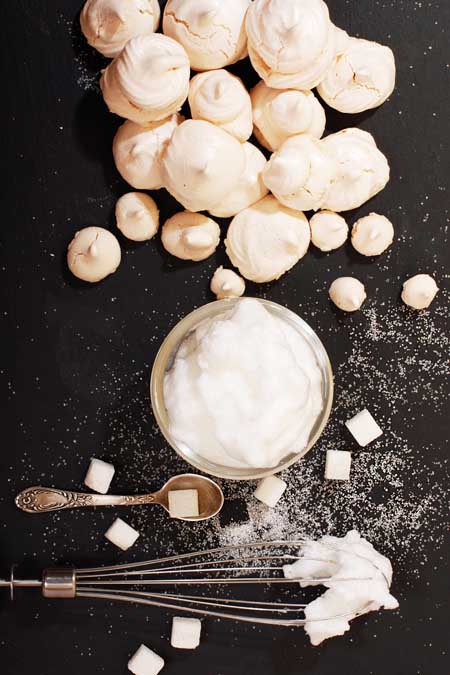
A tiny pinch of cream of tartar can also be helpful in a sugared meringue to make it as stiff as it needs to be, but this may be more of a trial and error situation.
Beat egg whites on medium speed to form soft peaks — simply meaning that the curls will fall over when you pull the beaters out. Make sure that your egg whites form soft peaks prior to adding sugar — otherwise, you’ll find yourself spending all day beating, and feel like you’re getting nowhere!
Turn the mixer up to high speed and add sugar slowly, one tablespoon at a time.
Once you’ve added the sugar, you’ll continue beating until it is completely dissolved. (Do be sure to make certain that the sugar is dissolved in order to avoid beading). Beat on high until stiff, glossy peaks are formed. Stiff peaks are indicated when the beaters are removed and the tips stand straight up, rather than curling over.
Topping Your Pie
At this point, if you are using your meringue for a pie topping, go ahead and spread it over the hot pie. This way, the meringue will begin to cook slightly, and this will help to keep it from pulling away from the sides of the pie, or “weeping.”
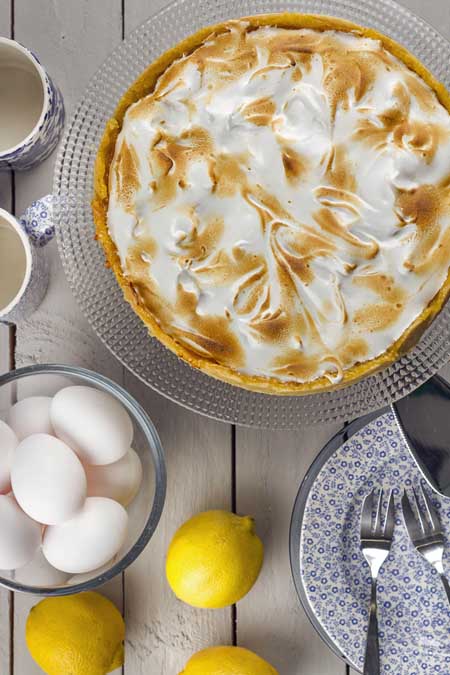
It may help to make the meringue prior to the filling, so that the meringue is given time to set up prior to use.
Then you can bake your pie at 425°F for just a few minutes, in order to brown the peaks. Four to five minutes should be enough, but watch carefully to be sure you do not burn it.
Options for Flavoring
Various options exist for flavorings, but this requires care, to be sure that what you add will not be detrimental to your recipe setting up. Some people like to add a bit of lemon juice prior to mixing, around ¼ teaspoon, to brighten the flavor of meringues made for use in fruit pies.
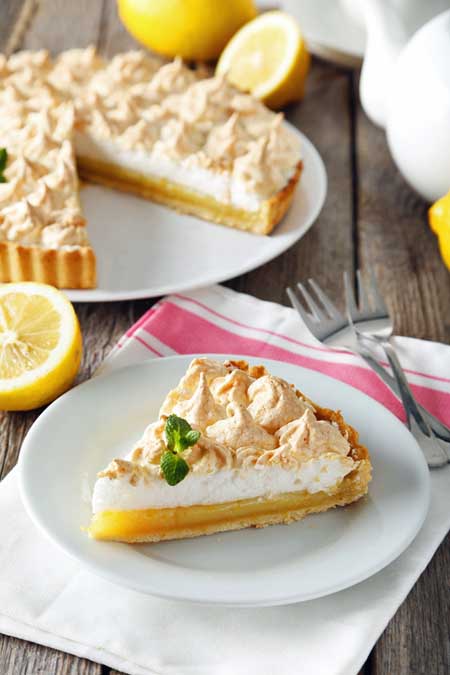
For a sweeter alternative, try folding in 1 teaspoon of vanilla extract at the end of the mixing process, prior to topping the pie.
Mastering the art of meringue may be something that you can become famous for among your friends. Just don’t tell them how absolutely easy it is!
Here’s a simple and easy recipe for when you need to whip something up for dessert, and you don’t want to go to the grocery store:
Melt in Your Mouth Meringue Cookies
Try these for a basic meringue recipe before advancing to anything more fancy.

You can use a frosting or icing applicator when adding them to the cookie sheet if you want a fancy shape, or just blob them on there if you aren’t too concerned about it.
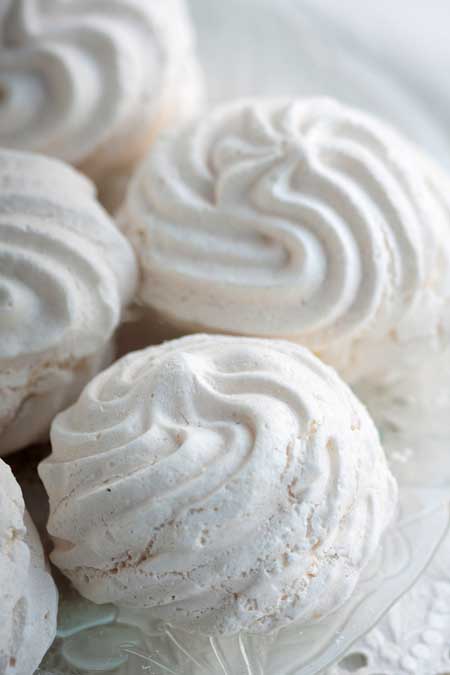
Also, you can use a microplane or grater to peel a little lemon zest to add for a bit of tanginess.
- 3 egg whites
- 2/3 cup granulated Sugar
- 1/4 teaspoon cream of tartar
- grated lemon zest or cinnamon optional
- Preheat oven to 250°F.
- Place room temperature egg whites and cream of tartar in a very clean bowl. Mix with clean, dry beaters until stiff. Add sugar gradually until stiff peaks form. Fold in flavoring such as grated lemon zest or ground cinnamon.
- Place on a cookie sheet lined with parchment paper in teaspoon-sized circles, two inches apart.
- Bake in preheated oven for 30 minutes, until centers are dry. Cookies should not be brown, but should come off of the sheet without sticking.
About Julie Workman
As a freelance writer for over 15 years, Julie Workman has been published in various magazines, books, and online media. She holds a college degree in Home Economics which she uses every day in overseeing her household and making her home a happy place for her family.

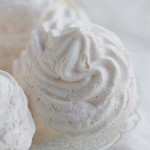

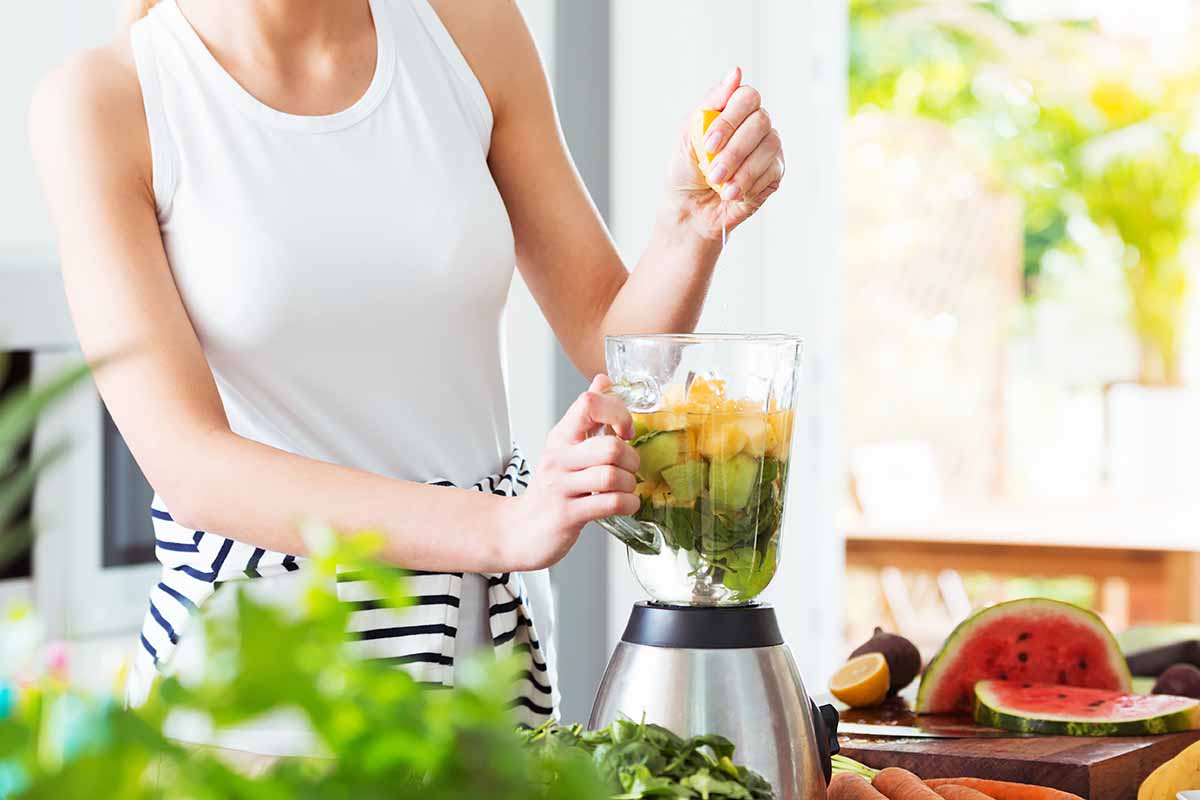

Thank you very much for the tips and the recipe. I’ve tried making meringue several times already, and it didn’t go so well. I’m not even sure what has gone wrong the other times. I do know one thing though. I’m sure that my next meringue trial is going to be amazing because I’m following your instructions to the T, I’ve already tried a few of your recipes and they’ve been winning dishes at home. Thanks again!
Hi Julie. I’m passing by to thank you for the tips and recipe. I found this article last week and was drawn to it because meringue was something that I had tried several times in the past and failed. I made a lemon meringue pie for Halloween this weekend. I did do a tiny variation to the meringue recipe. I added a very small amount of orange and red coloring to the meringue to go with the Halloween theme and it turned out great. At first I was scared and thought the meringue was going to turn out to watery, but it was perfect. Thank you much.
Thank you for the pointers. I have tried to make Meringue before but they always became sticky in the middle and would never dry through completely. The outer crust would be spot on but never was able to solve the stickiness issue.
After reading this article I built up enough courage to try again. Thanks.
Meringue is such an easy and delicious dessert, and you can make it easily on a whim. What I haven’t found yet is a good way to flavor it. I have seen at the supermarket small meringue cookies that have chocolate, pineapple. or other flavors, and I always feel like it’s a waste to buy them since meringue is easy to make. Do you have any pointers on that department that you can share? I haven’t ventured to experiment with the recipe by adding chocolate shavings or cocoa to the meringue in order to flavor it, precisely because meringue can be so delicate and egg whites lose their stiffness so easily.
I had no idea that the least bit of oil on your hands could mean the doom of the meringue! I also found it very interesting that colder eggs are easier to separate, I never really thought of it but it makes sense now that i think about it a bit more. I am very excited to try the cookie version recipe embedded in this post!
I need to try this out. I have tried my hand in making these a couple times with little to no success (unfortunately since I really love them and the taste).
I can’t help but to notice that meringue is referred to as “dairy free” in this article. Meringue contains egg whites, which are a dairy product.
ROTFLMAO
Ummmm…last time I checked dairy refers to milk. There is only one genus of animals on the planet that produce this substance…that would be mammals.
99.99999% of the eggs on the planet derive from insects, fish, amphibians, reptiles, and most importantly to our culinary pursuits, birds – you know those feathery decedents of dinosaurs?
Not too many mammals are popping out eggs and I don’t recall ever seeing duckbilled platypus eggs in the grocery store. If you ever see a cow or a milk goat laying an egg, then please take a picture and post it.
Just because it’s sold in the “dairy case” doesn’t make it a dairy product.
😀 lol
My sister makes what she calls meringue drop cookies, but she adds chocolate chips and walnuts into the batter as a little surprise!
I just made lemon meringue pie last week and had some problems. Although tasty, it pulled away from the sides of the pie, making it look a bit funny. I never knew you should add the sugar later, I always added all the sugar in the beginning! No wonder my arm almost fell off while beating the egg whites! Those cookies look delicious too.
Meringue cookies are one of my favourite sweets. I like to add a little almond or coconut extract to change up the flavor a bit, and then bake them until they’re still just a little soft inside. They go really well with ice cream this way. And because they’re mostly comprised of egg whites, they’re actually fairly low calorie too, which is always a bonus when you’re talking about dessert!
I really love meringues and also they remind me of pavlova cake. It is also egg white and sugar with fresh fruit and chocolate on it. I have seen Jamie Oliver do a Pavlova Cake and I tried it!
It was really nice looking also hard to eat.
I think this is my nemesis, I lost count of how many times I’ve tried to make it and failed, and I’m not even talking about how many eggs I’ve wasted in the process. Thank you for this spectacular recipe, it sounds foolproof, and I’ll make sure to follow every single step the next time I’ll gather the courage to try again. Your tips were precious, it’s amazing how sometimes the little details can make the difference. For example, I’ve always cracked the eggs on the corner of the counter or using a fork, I’ll never do it again! I need to try out this recipe soon, the cakes look mouthwatering and same goes for the cookies. I can’t wait to taste them!
I remember one time, my sister and I tried to make meringue cookies. We hand beat them (using a regular beater) for about, what, an hour or so (or maybe I’m exaggerating… I don’t really remember it much, but our hands were tired as hell afterwards). It didn’t really became fluffy, but since we were both tired of beating it (and didn’t really know how fluffy is “fluffy”), we just went on ahead and baked it. And alas… we failed T_T it became sticky and you could tell it was not well mixed. After that, we never tried to make meringue again -n-… But I guess with this, we can try again. I’ll make sure to take note of those tips/notes (like using a metal bowl, avoid oily hands amap, and that cold eggs are easier to separate). In fact, I’ll put them into my head so deep that they won’t be able to escape (lol), since they’re useful, not just for this recipe, but in other sweet recipes as well <3 Thanks~
Another very helpful hint is use a stand mixer. $75 and up on Amazon
I always ruin the meringue! It never fails, it just simply never turns out right. After reading this and giving it another go, with no mistakes, its the best one I have made so far. Though, I need to give it a bit more practice.
This is the second time I have tried using Erythritrol and when I come to pipe out the meringues water seems to drip out of the icing bag. Can I do anything to avoid this?
I’m not familiar with cooking with this sugar substitute, but I suspect that a different ratio may be required to prevent the whipped eggs from losing moisture. Make sure you’re beating them to shiny, stiff peaks as well. Hope this helps!
I followed the recipe exactly but the meringues where soft inside.
I baked them at 250 degrees for 30 minutes. What else can I do to have them hard inside ?? Please help ????????
Lots of different variables can have an effect on the final outcome of meringues, including the humidity level in your kitchen. Meringues are typically just a bit soft inside, but they should be cooked. Try a longer time at a lower temperature, if your oven will go lower. And be sure to allow them to cool completely.